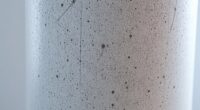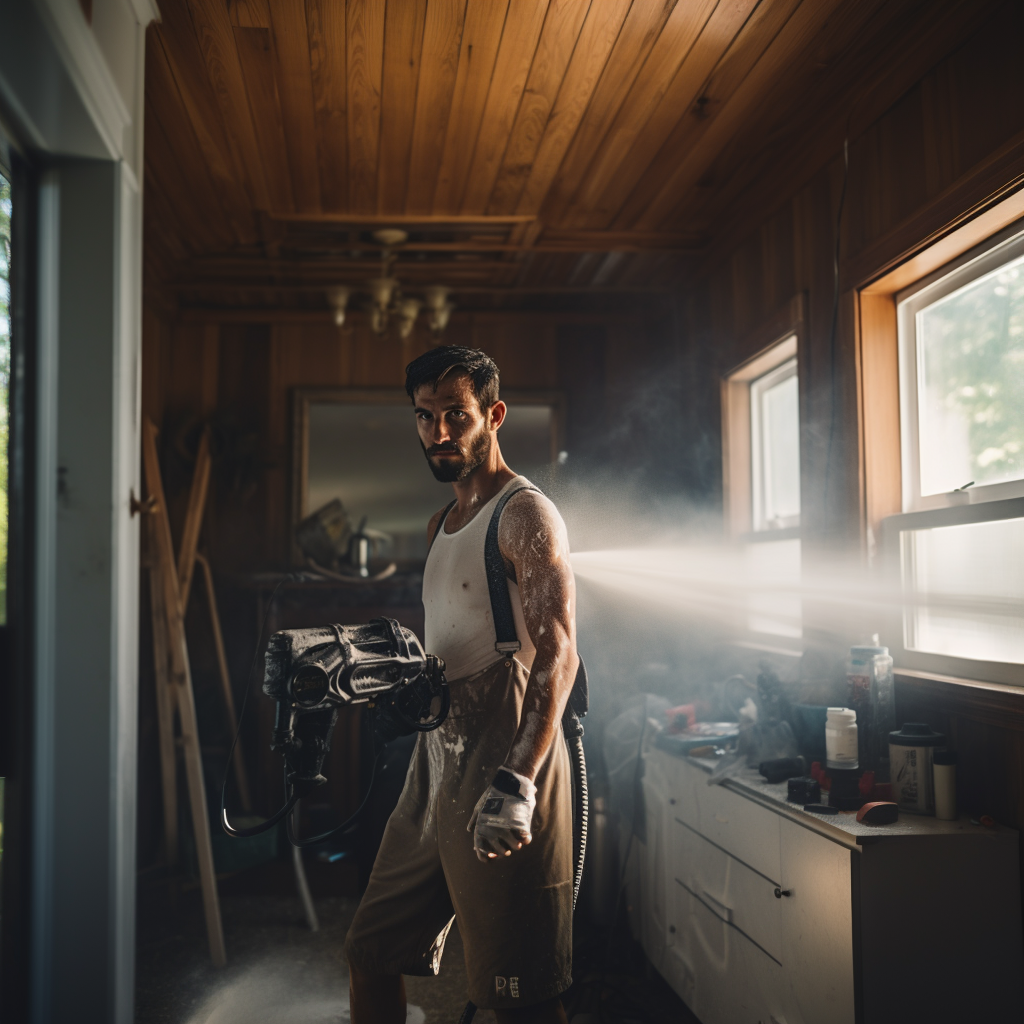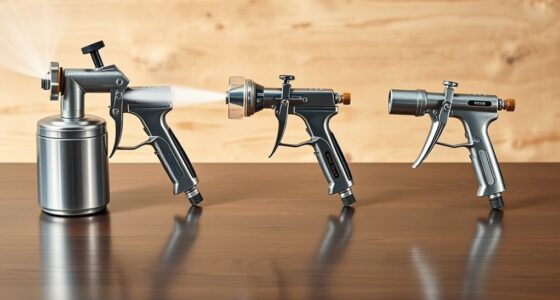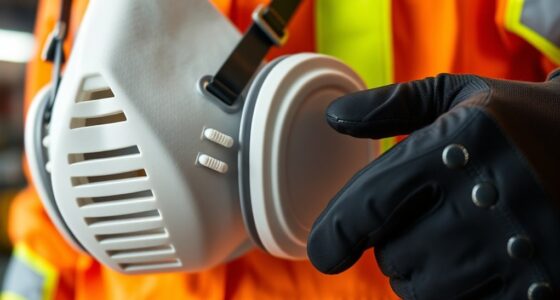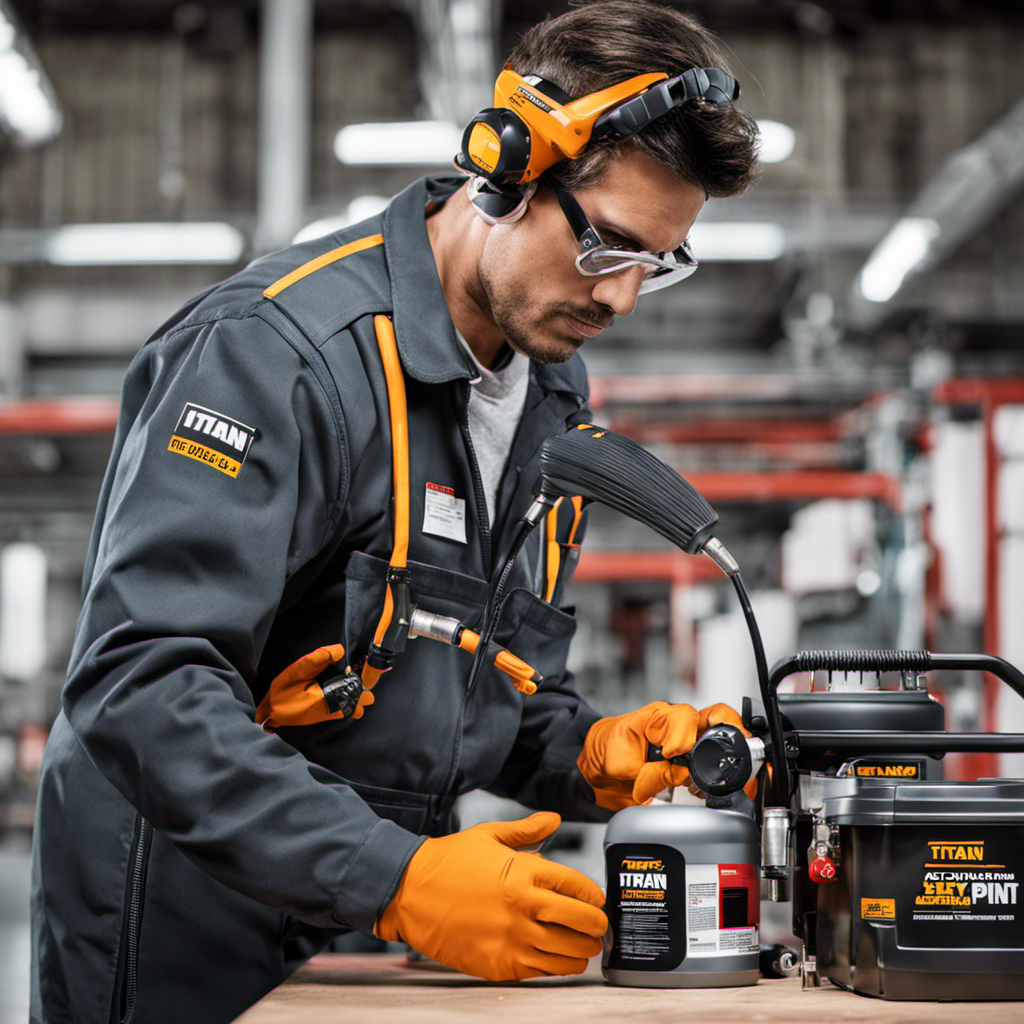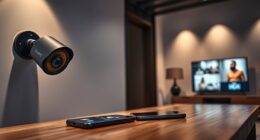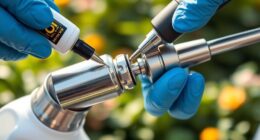Understanding paint viscosity cups helps you measure and control paint flow for your sprayer, ensuring a smooth, even finish. By selecting the right cup and calibrating it properly, you can maintain consistent viscosity, preventing issues like drips or poor coverage. Proper measurement guides you in adjusting paint mixes or thinners, saving time and rework. Keep going to discover how accurate viscosity readings can make all the difference in your spray projects.
Key Takeaways
- Selecting the correct viscosity cup ensures accurate measurement of paint flow, matching your sprayer’s requirements.
- Regular calibration verifies that the cup’s flow time aligns with standardized viscosity standards.
- Proper viscosity measurement helps prevent issues like drips, runs, and uneven coverage during spraying.
- Using the right cup and calibration techniques improves consistency and quality of your paint finishes.
- Understanding viscosity flow times guides you in thinning or adjusting paint for optimal spray performance.

Understanding paint viscosity cups is vital for guaranteeing consistent and high-quality coatings. When you’re working on a project, whether it’s a delicate finish or a rugged industrial coat, controlling paint flow is essential. This is where viscosity measurement becomes indispensable. Paint viscosity cups help you determine the thickness of your paint, which directly impacts how smoothly it flows through your sprayer. If the paint is too thick, it might clog your equipment or cause uneven coverage. If it’s too thin, you risk drips, runs, or insufficient adhesion. By selecting the right viscosity cup and calibrating it properly, you can maintain ideal paint flow and achieve a professional finish every time.
Cup calibration is the foundation of accurate viscosity measurement. It involves verifying that the cup’s flow time aligns with known standards. When you calibrate your cup, you ensure that the timing results are consistent and reliable. This process typically involves using a standard fluid with a known viscosity, pouring it into the cup, and timing how long it takes to drain through the opening. If the flow time doesn’t match the expected value, you can adjust your measurements or consider replacing the cup. Proper calibration means that when you test your paint, you’re getting an accurate picture of its viscosity, which helps you make informed adjustments to your formulation or thinning process.
Calibrating your viscosity cup ensures accurate, reliable paint flow measurements for better coating results.
Understanding the relationship between paint flow and cup calibration also helps you troubleshoot issues on the job. If your spray pattern is uneven or you notice drips, you might need to check if your viscosity cup is calibrated correctly. An uncalibrated or worn cup can give misleading readings, leading you to use paint that’s either too thick or too thin. Regularly testing and calibrating your cups ensures that your measurements stay precise over time. It’s a simple step that saves you time, material, and frustration by preventing problems before they start.
In addition, choosing the right viscosity cup depends on your specific application. Different cups have different flow rates and sizes, tailored for various types of coatings. Familiarizing yourself with these differences allows you to select the best tool for your needs and maintain consistent results. Proper cup calibration is crucial for accurate viscosity measurement, ensuring your paint flows correctly through your sprayer. Remember, accurate paint flow control hinges on both selecting the correct cup and properly calibrating it. When you do this, you take control over your coating process, ensuring uniform, high-quality finishes with fewer reworks or touch-ups. Ultimately, mastering the use of viscosity cups and cup calibration empowers you to deliver professional results with confidence and precision.
Frequently Asked Questions
How Do Temperature Changes Affect Viscosity Cup Readings?
Temperature changes can considerably impact viscosity cup readings because they affect temperature stability. As temperatures rise, paint thins out, leading to lower viscosity measurements, while cooler temperatures increase viscosity. Fluctuations in temperature cause inconsistent results, so it’s essential to maintain a stable environment. By controlling temperature and allowing paint to reach equilibrium, you guarantee accurate viscosity readings, resulting in better spray performance and a smoother finish.
Can Viscosity Cups Be Used for Thick or Latex Paints?
Did you know that viscosity measurement is essential for achieving perfect paint consistency? Viscosity cups can be used for thick and latex paints, but you need the right type. Thick paints may require a larger or specialized cup to accurately measure flow. Latex paints, being more fluid, often work well with standard cups. Always choose a viscosity cup suited for your paint’s thickness to guarantee proper mixing and spraying results.
What Calibration Is Needed for Different Viscosity Cups?
You need to perform calibration procedures specific to each cup size to guarantee accurate viscosity measurements. Start by timing how long it takes for paint to flow through the cup at a known viscosity. Record these times, and adjust your readings accordingly for different cup sizes. Regular calibration helps you maintain consistency, especially when switching between different viscosity cups, ensuring you get the right mix for your sprayer every time.
How Often Should Viscosity Cups Be Cleaned?
Ever wonder how often you should clean your viscosity cups? Regular cleaning keeps them performing at their best, preventing paint buildup that skews your results. Follow a consistent maintenance schedule—ideally after each use or at least weekly if used frequently. Cleaning frequency depends on your project’s scope, but don’t let grime accumulate. Staying diligent guarantees accurate measurements, prolongs your equipment’s life, and keeps your spray jobs flawless.
Are Digital Viscosity Measurement Tools More Accurate?
Digital viscosity measurement tools can be more accurate if they’re properly calibrated regularly. You benefit from digital calibration, which guarantees measurement consistency and reduces human error. Unlike traditional cups, digital devices provide quick, precise readings, making it easier to maintain the right paint viscosity. Keep in mind, consistent calibration and proper maintenance are key to getting the most accurate results from your digital viscosity tools.
Conclusion
Now that you understand how paint viscosity cups work, you’ll be better equipped to get your mix just right. Remember, a little knowledge goes a long way—don’t put all your eggs in one basket. By choosing the right cup and measuring accurately, you’ll guarantee a smooth spray every time. So, don’t be afraid to roll up your sleeves and get your hands dirty; mastering this skill will save you time and frustration down the line.
Franz came aboard the Paint Sprayer Zone team with a background in both journalism and home renovation. His articulate writing style, combined with a passion for DIY projects, makes him an invaluable asset. Franz has a knack for breaking down technical jargon into easy-to-understand content, ensuring that even the most novice of readers can grasp the complexities of paint sprayers.

